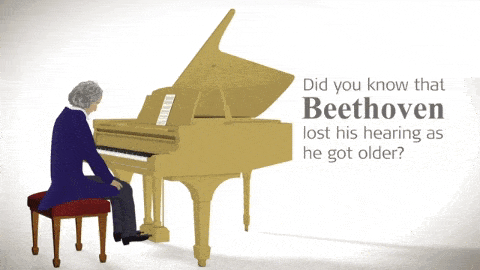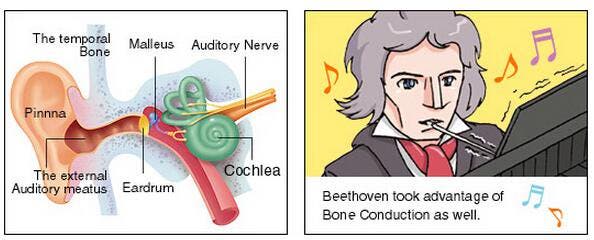On May 7, 1824, the legendary 9th Symphony premiered in the Theater am Kärntnertor in Vienna. When the masterful performance ended, 54-year-old Beethoven, who was stone deaf at this time, was still conducting along with the “official conductor” from the front row when he had to be turned around to face the thunder of an applauding audience.
Whilst Beethoven’s career was the stuff of genius, his personal life was marked by a struggle against deafness and constant suffering caused by an armada of afflictions. The German composer first noticed that his hearing was fading around the age of 28. By this time he was already an established figure in the Vienna musical scene and regarded as a rising star rivaling Wolfgang Amadeus Mozart, which only made everything worse.
One can only imagine how cruel a fate that must have felt like to such a musical mind. He, the great Beethoven, of all people, was going deaf! It’s as if Picasso lost his eyesight or Rodin had his arms cut off.
But Beethoven was a strong-willed spirit who didn’t give up easily. One of his celebrated phrases is: “I will choke on the throat of fate, it will never make me succumb.”
He was true to his word. Despite his rapidly deteriorating hearing, from 1803 to 1812, Beethoven composed an opera, six symphonies, four solo concerti, five string quartets, six-string sonatas, seven piano sonatas, five sets of piano variations, four overtures, four trios, two sextets, and 72 songs.
Beethoven… the inventor?

Despite living in pain, Beethoven did not give up. However, he had a helping hand. In order to continue composing and playing music, Beethoven stumbled across a physical phenomenon that is central to hearing: bone conduction.
At the time, scientists understood very little about how human hearing works. But despite the fact that his ears left him, he could still hear himself playing music by placing one end of a wooden stick onto his piano and clenching on the other end with his teeth. When notes were struck, the vibrations from the piano were transferred to his jaw, and from there directly to his inner ear. Miraculously, he could hear again! Bone conduction was born.
Sound is nothing more than acoustic vibration in the air. These juggling atoms vibrating at certain frequencies cause the eardrum to vibrate, which are transformed into a different kind of vibration that the cochlea, also known as the inner ear, can interpret. The cochlea then transmits the information about the sound to the brain via the auditory nerve where it is processed as hearing.
But there’s a second way that humans can hear besides air conduction. If the inner ear is directly exposed to acoustic vibration in the bones, then a person can still hear although the eardrum is bypassed. This is one of the reasons you can still hear your own voice if you plug your ears. It’s also how whales hear while diving deep in the ocean or how male elephants can listen for mating calls by stomping females several kilometers away.

Beethoven’s clever bone-conducting solution is used in some hearing devices today. A bone conducting hearing device, or BAHA, converts the sound picked up by its microphone into vibrations that are transmitted through the bones of the skull to the cochlea of the inner ear. Essentially, the bone conducting device fills the role of a defective eardrum.
Bone conduction hearing devices are also used by people with perfect hearing in certain applications. For instance, military headsets allow soldiers to hear orders relayed through a bone conduction device, sometimes integrated into the helmet, despite the background noise of enemy gunfire. Special bone conduction hearing devices also allow divers to both hear and talk underwater.
Beethoven’s final struggles with deafness
The way Beethoven dealt with his deafness is one of the great stories of humanity. The cause of his deafness, though, remains something of a mystery.
His diagnosis is made all the more challenging since he suffered from a plethora of other illnesses. The list includes chronic abdominal pain and diarrhea that might have been due to an inflammatory bowel disorder, depression, alcohol abuse, respiratory problems, joint pain, eye inflammation, and cirrhosis of the liver.
This last item, a consequence of his prodigious drinking, may have ultimately killed Beethoven, who died in 1827. An autopsy showed signs of severe cirrhosis, but also dilatation of the auditory and other related nerves in the ear.
As a common custom of the time, a young musician by the name of Ferdinand Hiller snipped off a lock of hair from Beethoven’s head as a keepsake. The lock stayed in the Hiller family for nearly a century until it somehow made its way into the hands of a Danish physician called Kay Fremming. The physician is famous for saving thousands of Jews during the occupation of Denmark by Nazi forces by helping them escape to Sweden, whose border was closeby to a tiny fishing village Fremming called home. Some speculate that one of the Jewish refugees gave Dr. Freeming the lock of Beethoven’s hair in gratitude for saving their lives.
What we know for sure is that the lock of hair, consisting of 582 strands, was passed down to Fremming’s daughter, who put it up for auction in 1994. It was purchased by Alfredo Guevara, an Arizona urologist, for a modest $7,000. Guevara kept a few strands and donated the rest to the Ira F. Brilliant Center for Beethoven Studies at San Jose State University in California.
At this point, scientists at the university thought of examining DNA from the great composer’s hair in order to look for clues as to how Beethoven became deaf.
The hair was put through a barrage of DNA, chemical, forensic, and toxicology tests. What immediately stood out was an abnormally high level of lead. During Beethoven’s time, people weren’t aware of lead poisoning and it was quite common to use plates for food and goblets for drinking made out of the toxic metal. Even the wine of that era, Beethoven’s favorite drink, often contained lead as a sweetener. This severe lead poisoning may have contributed to the composer’s lost hearing.
For a long time, Beethoven tried to conceal his deteriorating hearing, fearing that this may ruin his career if the word was out. But he couldn’t keep it up for too long. It was common for composers to also conduct and even perform their own music, and Beethoven’s condition eventually became noticeable. After watching one of Beethoven’s piano rehearsals in 1814, fellow composer Louis Spohr said “…the music was unintelligible unless one could look into the pianoforte part. I was deeply saddened at so hard a fate.”
At age 45, Beethoven’s hearing was completely gone, and so was his public life. In the final stretch of his life, the German composer became a reclusive, insular person who allowed only a select few friends to visit him. The music he composed during this time, which includes the famous Sixth Symphony, reflects Beethoven’s love for nature and his life in total silence in the countryside. Describing the Sixth Symphony, Beethoven said it is “more the expression of feeling than painting”, a point underlined by the title of the first movement. While completely deaf, Beethoven also composed Missa Solemnis, the solemn mass for orchestra and vocalists, and the opera Fidelio, among other major works.
It’s not clear if Beethoven’s inner ear was still functional in his later days so that he could continue using his bone-conducting stick to hear his compositions on the piano. Many experts believe he didn’t need to hear his pieces anyway since he was a master composer who knew all the rules of how music is made. Even in deafness, Beethoven was an unparalleled master of the language of music and an inspiration for resilience.


